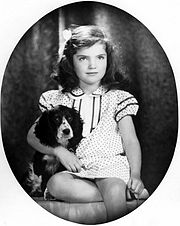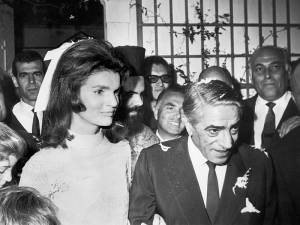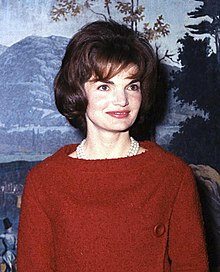John, Paul, George and Ringo may have been right in asserting that all you need is love. What we do not need, however, is another word spoken or written about Jacquelyn Bouvier Kennedy Onassis (1929−1994). She has been the subject of 33 million—I exaggerate only slightly—articles, books and films, and here I am adding to that mountain of Jackie-mania. I doubt my take is at all unique, and yet I feel compelled to write about the woman who was for many years undoubtedly the most famous in the world.
“Black Jack’s” daughter
Her mother was of Irish descent and her father French. “Black Jack” Bouvier was quite a rascal. He charmed, he drank, he gambled, he chased skirts shamelessly, and he allowed much of the family  fortune to disappear with the arrival of the Depression. His eldest daughter (sister Lee was four years younger) was, nevertheless, accustomed to the finer things in life from the start. Born and raised on Long Island, New York, she was an equestrienne, a debutante and a student at the best finishing schools on the East Coast. Jackie was tall, had wide-set eyes, spoke with a breathy voice and carried herself like royalty.
fortune to disappear with the arrival of the Depression. His eldest daughter (sister Lee was four years younger) was, nevertheless, accustomed to the finer things in life from the start. Born and raised on Long Island, New York, she was an equestrienne, a debutante and a student at the best finishing schools on the East Coast. Jackie was tall, had wide-set eyes, spoke with a breathy voice and carried herself like royalty.
It would have been gauche to say so out loud, but her main goal—as with virtually all other young women at that time and in her social class—was to marry well. Emotional and sexual compatibility were secondary to money. As the old saying goes, RO-mance without FI-nance is a NUI-sance. She once advised a female friend to look for “a man with money, real money.” Jackie was well positioned to offer such counsel because she had married into the Kennedy family. Joseph Kennedy became quite wealthy from banking, liquor, Hollywood, steel and the stock market; in contrast to Black Jack, old man Kennedy profited handsomely from the Depression. He was bound and determined that his second son, John Fitzgerald, would become president of the United States. One requirement for that was a five-star wife, and Jackie fit the bill.
Social event of the season
JFK, then a relatively undistinguished senator from Massachusetts, married her at St. Mary’s Church in Newport, Rhode Island on September 12, 1953 in front of 700 guests (a reception for 1,200 followed). It was the social event of the season. Even before saying “I do,” Jackie must have been aware that her hubby knew no more about fidelity than about quantum mechanics. I am a red-blooded heterosexual male myself, so I understand the draw to females of the species. But if ever there was a woman to be faithful to, it had to be Jackie Kennedy. She was beautiful, well-educated (I forgot to mention that she graduated from George Washington University in 1951, majoring in French literature) and a scintillating conversationalist. What more could you ask for, Johnny? There is no need to rehash what is now well known, that Kennedy was a stone-cold sex addict. That was the case for the entire 10 years of their marriage, and it got more frenzied, not less, after he won the 1960 presidential election. As the motorcade rolled through Dallas on November 22, 1963, I have a fairly good idea what was on  Kennedy’s mind—something a bit earthier than politics, civil rights, economics or the burgeoning war in Vietnam.
Kennedy’s mind—something a bit earthier than politics, civil rights, economics or the burgeoning war in Vietnam.
Jackie’s presence that fateful day surely helped to create a buoyant mood. Dallasites were cheering her as much as him. When the bullets from Lee Oswald’s rifle rang out at 12:30 p.m., two of them hit the president (the first going on to also hit Texas Governor John Connally). What a painful memory this is. Jackie climbed up on the trunk of the limousine to retrieve a portion of her husband’s head that had been blown off. She later claimed to have no memory of doing that. Refusing to change out of her blood-spattered pink Chanel dress, although her pillbox hat had somehow been lost, she said repeatedly, “I want them to see what they have done.” These were the words of a traumatized woman, and so she must be given considerable slack. But I want to say, as gently as possible, that she was all wrong. No conspiracy led to her husband’s murder in Dealey Plaza. The misanthropic Oswald planned it from start to finish. He had no confederates, nor was he manipulated into pulling the trigger. He was not a patsy, as he would claim after his apprehension and transfer to Dallas Police Headquarters. Mrs. Kennedy’s words should have been “I want him to see what he has done.”
Her stoic demeanor during those excruciating days was the cause of universal admiration. Even her children, Caroline and John Jr., played their roles perfectly. Time did go on, however. They moved out of the White House and eventually left Washington.
Life after JFK
Jackie lived another 31 years after the assassination. No two-dimensional character, she eventually began to smile and laugh again. She went to parties and had sexual relationships including—scandal, scandal—with her dead husband’s two surviving brothers, Bobby and Teddy. The press closed its eyes to this as it had to the foibles of JFK.
If anything caused Jackie’s adoring public to doubt her, it was her 1968 wedding to Greek shipping magnate Aristotle Onassis. These two had little in common, and the marriage soon faltered with  recriminations on both sides. But each represented something the other wanted. For him, she was the ultimate trophy wife. For her, he offered financial stability in abundance. When Onassis died in 1975, she got a $26 million settlement—not to be confused with chump change. Later in life, she had a long-term relationship with a Belgian-born diamond merchant named Maurice Templesman. They did not marry, but it is a fact that JFK, Onassis and Templesman all had what she called “real money.”
recriminations on both sides. But each represented something the other wanted. For him, she was the ultimate trophy wife. For her, he offered financial stability in abundance. When Onassis died in 1975, she got a $26 million settlement—not to be confused with chump change. Later in life, she had a long-term relationship with a Belgian-born diamond merchant named Maurice Templesman. They did not marry, but it is a fact that JFK, Onassis and Templesman all had what she called “real money.”
In between high-society doings, fox hunting at her Virginia estate and jet-set traveling, she worked as an editor at a couple of Manhattan publishing houses. She generously lent her name and sometimes donated money to worthy causes. Jacquelyn Bouvier Kennedy Onassis, diagnosed with non-Hodgkins lymphoma, died on May 18, 1994, and her legacy is unshakeable She is still regarded as one of the most admired Americans in the second half of the 20th century.


Add Comment